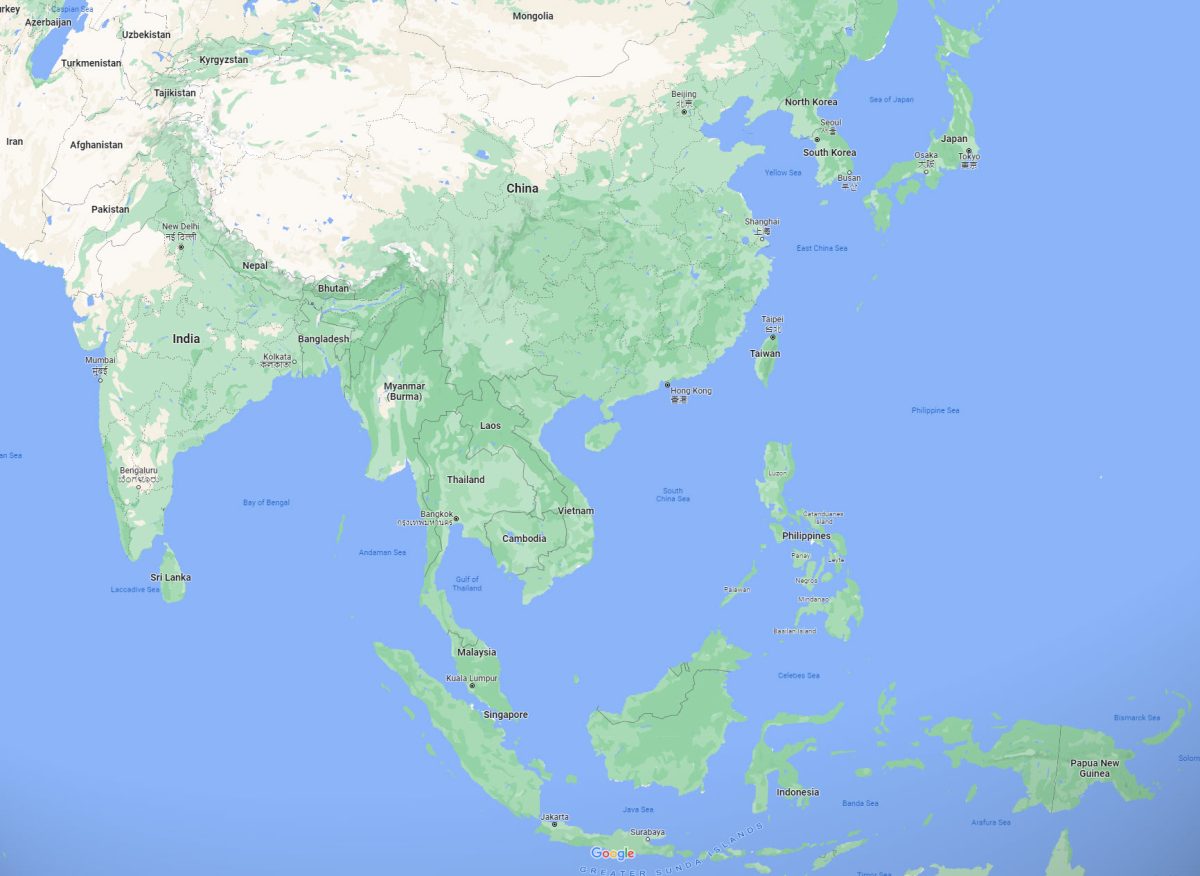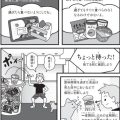Cities in China and Germany taking bold circular development as daring climate action
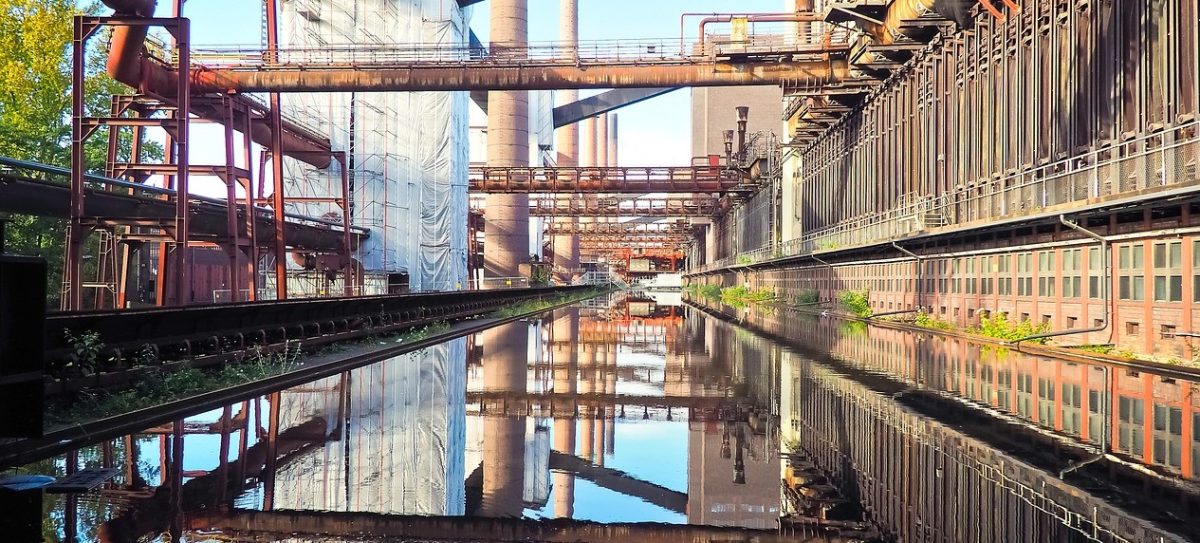
As one of the annual activities of the Green Circular Cities Coalition, the ICLEI East Asia Secretariat co-hosted the webinar “Bold Circular Development as Daring Climate Action” with the GIZ IWM NAMA Project under the framework of Daring Cities 2020, attracting over 60 participants from home and abroad. On this occasion, representatives from Essen of Germany, Shanxi Province, Suzhou and Hong Kong of China, and experts from Tsinghua University, GIZ, and the Ellen MacArthur Foundation shared cities’ experiences in utilizing industrial waste circularity and food waste recovery at the local level, and how the measures contribute to the their climate action goals.
Shu Zhu, Regional Director of ICLEI East Asia, welcomed the guests and participants in the opening speech. He highlighted that, while the ambitious commitments to achieve carbon neutrality by 2050 made by leaders around the world are significant for advocating global climate action, cities can make contributions by reducing carbon emissions in industries, buildings and construction, as well as the food sector by transitioning to a circular economy.
Industrial Waste Recycling
Coal gangue, fly ash and other coal mining by-products are the main sources of bulk solid waste in Datong – one of the oldest industrial cities in China. Li Wei of the ShanXi Coshare Research Institute, introduced the city government’s efforts in promoting the reuse of industrial waste by introducing Bulk Solid Waste Base projects that encourage cooperation between the coal industry and the chemical, power and steel industries. For instance, by sending coal directly to power plants, the Tongmei Datang Tashan Power Generation Project has built up a circular industrial chain of coal on-site conversion with industrial waste utilized comprehensively. Finally, Wei also shared the challenges the city has encountered in constructing bulk solid waste bases, and suggested that new management and operation systems, technology innovation and expansion of financial investments could be advantageous for such projects.
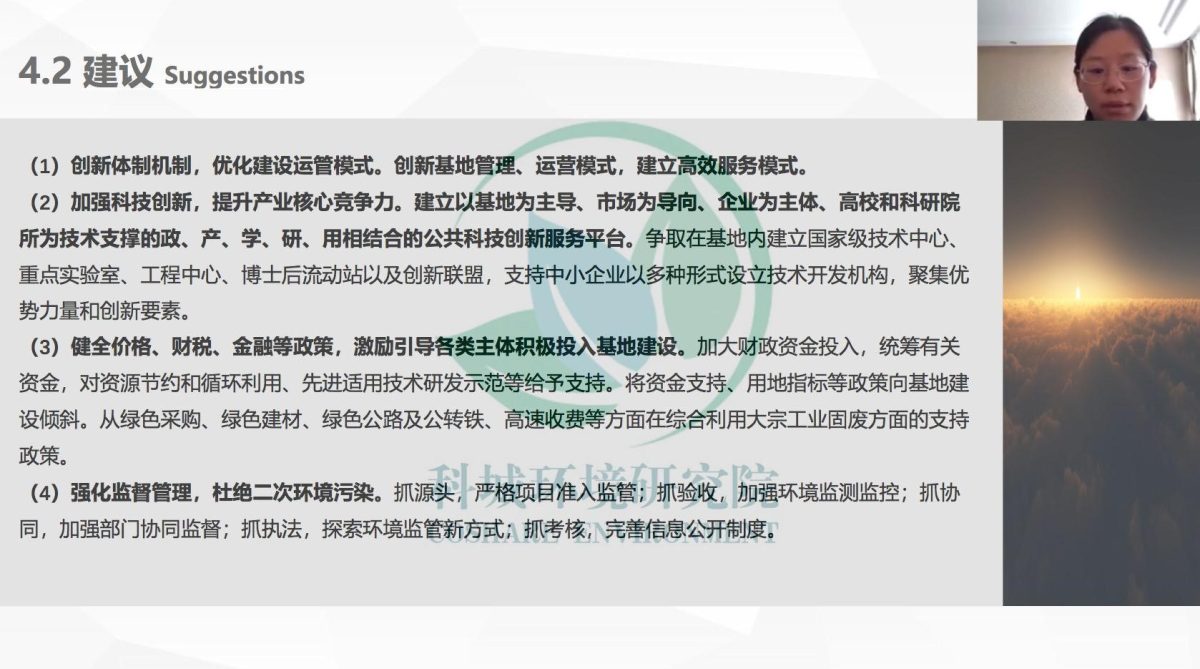
Li Wei of the ShanXi Coshare Research Institute
The German city Essen is also an industrial legacy city with a long history of mining, but has managed to gradually transform itself from grey to green over the course of 150 years. The city sees the process of transformation as an opportunity to “rethink and shape the future”, and adopts a comprehensive transition approach by combining the United Nations Sustainable Development Goals, climate actions, circular development, as well as waste management.
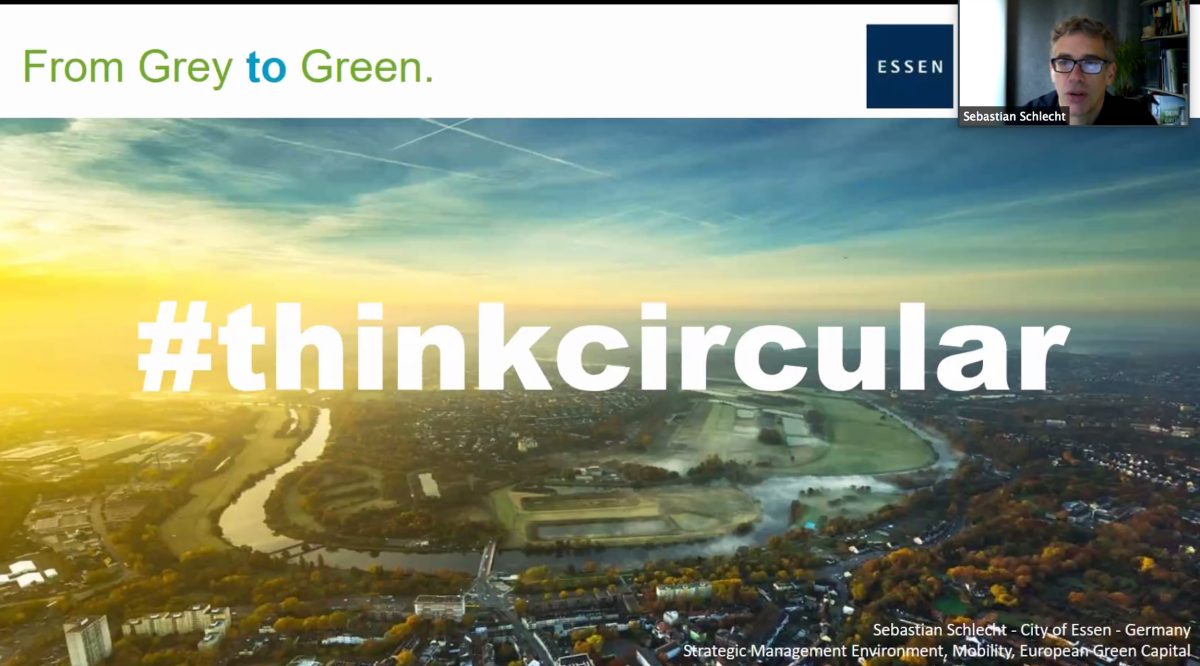
Sebasitian Schlecht, Strategic Management at the Environment Department, City of Essen
Sebastian Schlecht from the Environment Department of the City of Essen, shared the two most representative cases of the city’s green transition. The Zollverein Coal Mine Industrial Complex, a large formal industrial site where coal towers and coking plants are located, is now an ecological park composed of exhibition and conference centers, university campuses, research institutions, and the Ruhr Museum. The Complex has been inscribed into the UNESCO list of World Heritage Sites since 2001. In addition, to achieve the goal of a 95% reduction in carbon emissions by 2050, the City of Essen established the Green Hydrogen Utilization Center, aiming to utilize hydrogen derived from green electricity production to supply energy for transportation, construction, and industrial sector, as a means to effectively reduce carbon emissions while fostering green and circular development.
Echoing the case of Datong, Professor Zongguo Wen of the School of Environment, Tsinghua University, shared the results of his research on recycling industrial waste among various industries. He argues that extensive recycling of industrial waste among industries can greatly expand their potential in energy conservation and emission reduction, and is expected to become one of the key policy focuses for cross-industry cooperation in the future. For instance, cities can make use of material, residual pressure and waste heat utilization technologies, along with mediums such as waste gas, waste water and solid waste, creating linkages between waste generation and utilization industries to recycle industrial waste, save energy, and co-control pollutants emissions.
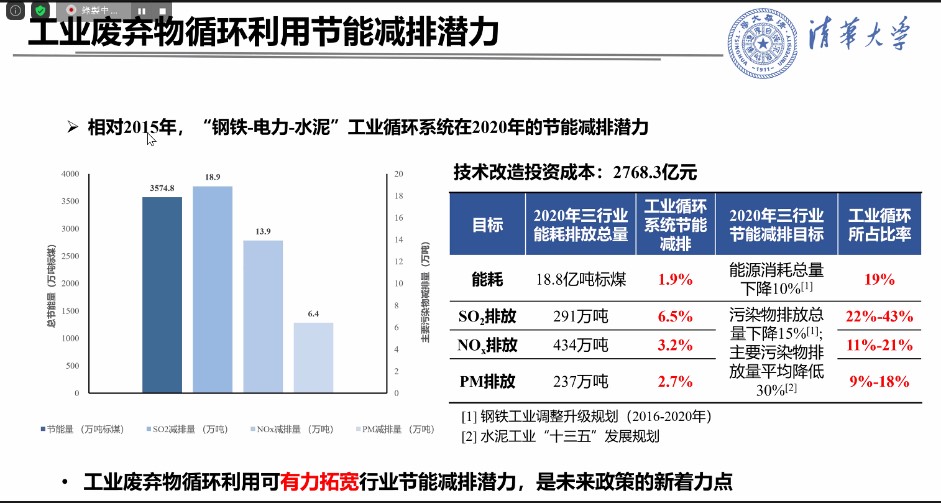
Source: Professor Zongguo Wen
As an example, Professor Wen presented the research on cross-industry recycling of industrial waste by his team in the Circular Economy Demonstration Park of Wu’an City, Hebei Province. By utilizing 11 recycling technologies, the Park created material recycling loops among industries surrounding the cement plant. While burnable waste collected from the municipal solid waste landfill is turned into combustibles to replace coal in cement manufacturing; the slag and desulfurized gypsum by-products from the iron and steel plant and the thermal power plant are turned into cement.
Food Waste Recovery
GIZ’s China Integrated Waste Management NAMA Project takes the perspective of product life cycles, and focuses on the GHGs reductions brought about by urban waste management and resource utilization technologies. On this occasion, the Project Director Mingyu Qian presented the Waste Management Key Performance Indicator (KPI) system and the MRV model the project team developed to provide science-based support and suggestions to the pilot cities.
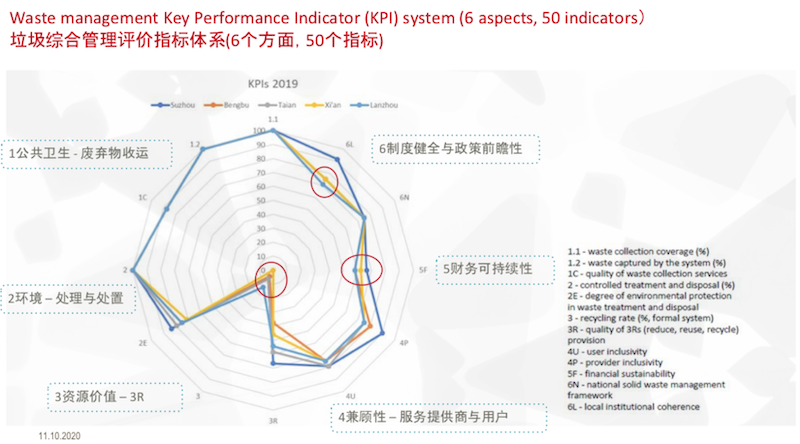
Source: GIZ
So far, five Chinese pilot cities have completed the evaluation of their local waste management system using the project tools. The results suggest that most cities underperformed in the “Quality of 3Rs (Reduce, Reuse, Recycle) Provision”, implying a huge potential to further utilize the circular economy approach in their current waste management systems. In addition, by evaluating the emission reduction potential of waste collection, transportation, disposal and recycling with the MRV model, the pilot cities and the project team have also found out that there are still enormous potentials for cities to reduce emissions in the field of recycling and organic waste treatment.
For instance, as one of the GIZ China IWM NAMA Project cities, Suzhou is sending all non-household food waste in the city for centralized treatment, and has established an integrated management and information system on the full process of non-household food waste collection and transport. During the webinar, Sheng He, Deputy Director of the Suzhou Environmental Sanitation Management Division, showcased the city’s food waste recovery approach with the Huayan Environment Non-household Food Waste Project as an example.
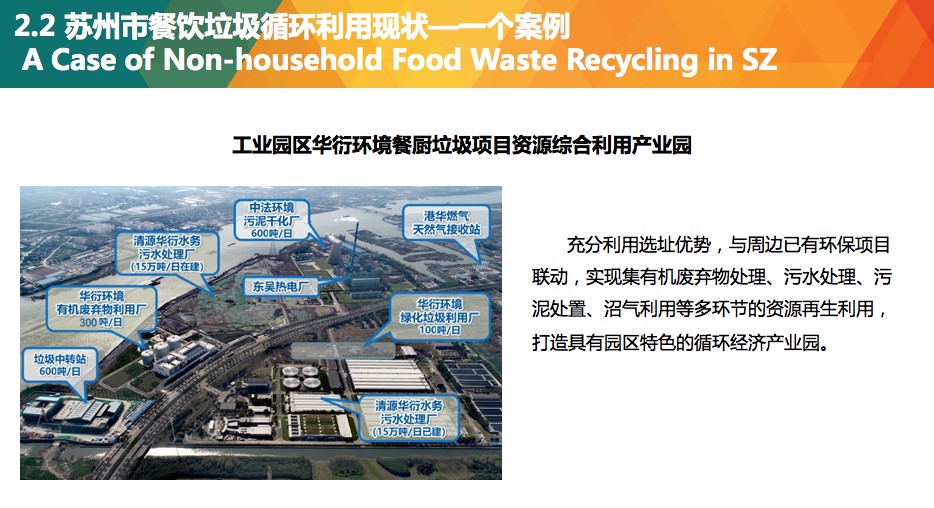
Source: Suzhou Environmental Sanitation Management Division
As a centralized waste treatment facility, the Huayan Environment Organic Waste Utilization Plant chose to sit close to other facilities such as a thermal power plant, a natural gas power plant and an urban landscaping waste utilization plant. Biogas residues from anaerobic digestion of food waste at the Plant, together with waste from the urban landscaping waste will be turned into fuel rods and used to supply the operation of the thermal power plant; whereas biogas generated through the process will be compressed and transported to the natural gas power plant, and later purified for residential use.
Currently, household food waste in Suzhou is mostly being treated by the small to medium-sized on-site facilities installed throughout the city. The city government will continue to explore the usage of organic waste products, improvement of the waste disposal charging system, as well as the possibility of co-treating food waste with other types of waste.
As one of the most densely populated cities in the world, Hong Kong generates 11,000 tons of municipal solid waste every day, with over one-third (around 3,600 tons) being food waste. During the webinar, Nesta Lee from the Environmental Protection Department of Hong Kong shared the city’s approach to reducing and recycling food waste.

Nesta Lee of the Environmental Protection Department of Hong Kong
To reduce food waste, the city government initiated the ‘Food Wise Hong Kong Campaign’ to raise public awareness, and actively supports NGOs and citizen groups’ activities and projects to reduce food waste generated by households, businesses, and industries. In addition, Hong Kong established the city’s first organic resource recovery center O•PARK 1 in 2018. With anaerobic decomposition technologies adopted, O•PARK 1 is able to convert 72,000 tons of food waste into approximately 14 million kilowatt-hours of electricity (equivalent to the electricity consumption of 3,000 households) per annum, while reducing 25,000 tons of carbon emissions. The city government plans to build a total of 5-6 organic resource recovery centers to convert food waste into biogas for electricity generation.
On the other hand, Hong Kong has also kicked off free food waste collection services in the city. In the first phase, the government collaborated with hospitals, supermarkets, traditional markets, schools and commercial buildings to set up and operate 120 food waste collection points. As of 2019, an average of 100 tons of food waste could be collected daily through these services. For the next phase, the city government is expanding the services to cover the whole city realm. Last but not least, Lee emphasized that the Hong Kong government will further understand the difficulties in food waste reduction and recovery in different sectors, and provide more free and practical support to local businesses and industries.
The Ellen MacArthur Foundation believes that the ultimate goal of a circular economy in food systems is to regenerate natural systems by closing the nutrient loop. Ying Gao, Food Initiative China Program Manager of the Ellen MacArthur Foundation, presented the cases of Brussels, Porto, and São Paulo, which, together, contributed to approximately 146,000 tons of GHG emissions reduction per year by adopting circular economy thinking in their food systems. She further argued that ‘if cities can adopt circular economy thinking in the cultivation, procurement, design, and consumption processes of food systems, the world will have the opportunity to reduce 4.2 billion tCO2e and can bring about an economic benefit of about 700 billion USD annually by 2050. Finally, with the cases of turning organic waste into high-value products such as clothing made from orange peel, leather made of grape fiber, and skincare products made of milk fiber, Gao encouraged cities and the participants to think outside the box, and actively explore various possibilities for food waste beyond incineration and landfill.
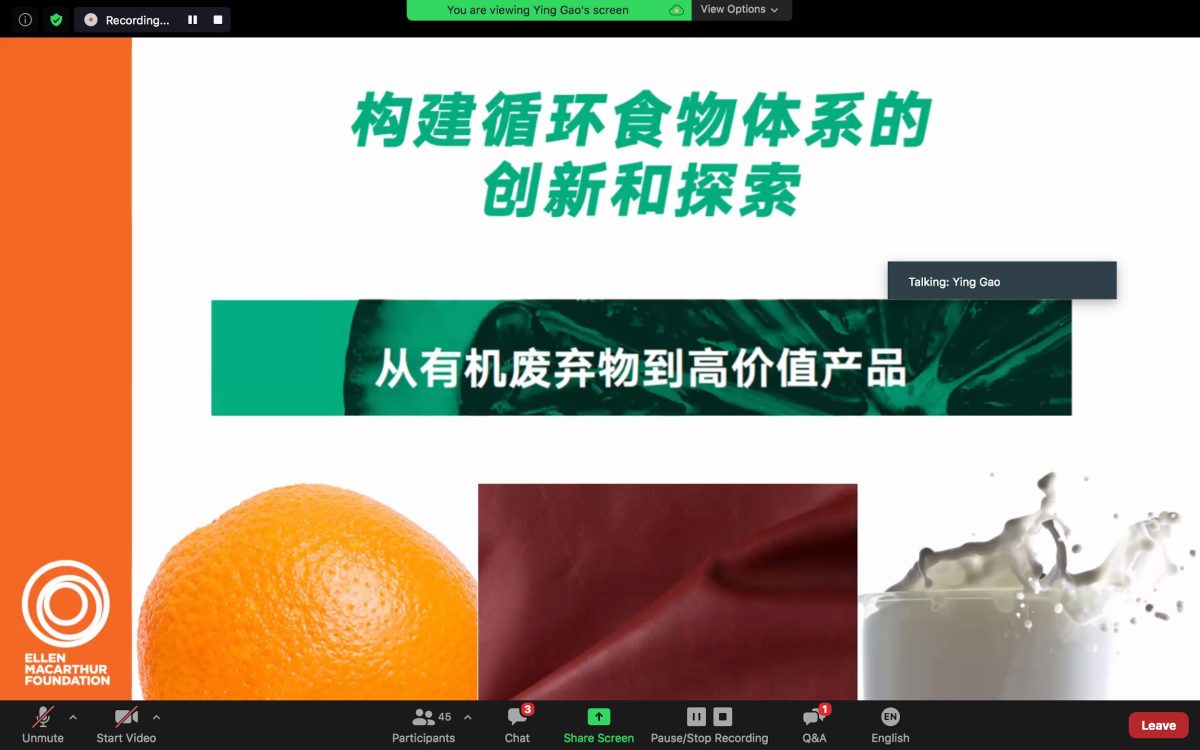
Source: Ellen MacArthur Foundation
With the support of governments, businesses, and academia, the webinar “Bold Circular Development as Daring Climate Action” has provided a peer-to-peer exchange platform for city officials, experts, and practitioners, while allowing cities to present their local practices on industrial waste recycling and food waste recovery to the general public. ICLEI East Asia will continue to bridge cities, experts, industries, and knowledge partners through the Green Circular City Coalition, and support cities in advancing circular and low-carbon development, in moving towards a sustainable future.
Daring Cities 2020 is a global, action-oriented virtual forum, designed by ICLEI and the City of Bonn, to empower urban leaders around the world to tackle the climate crisis.

